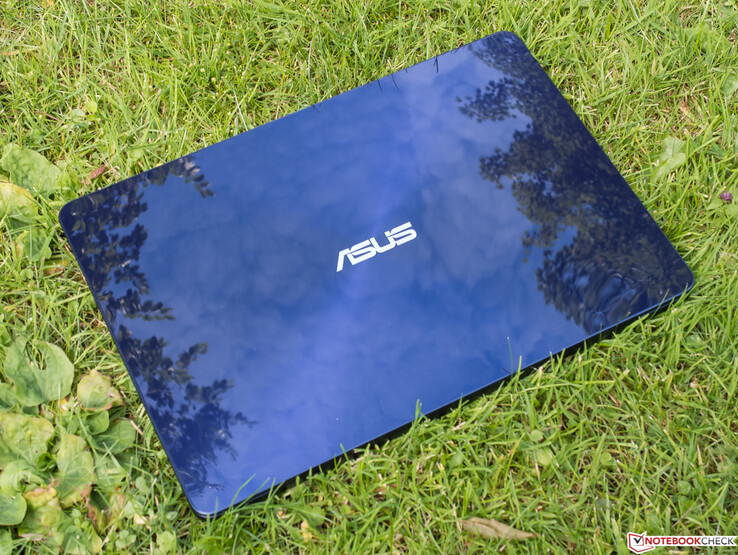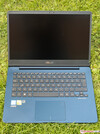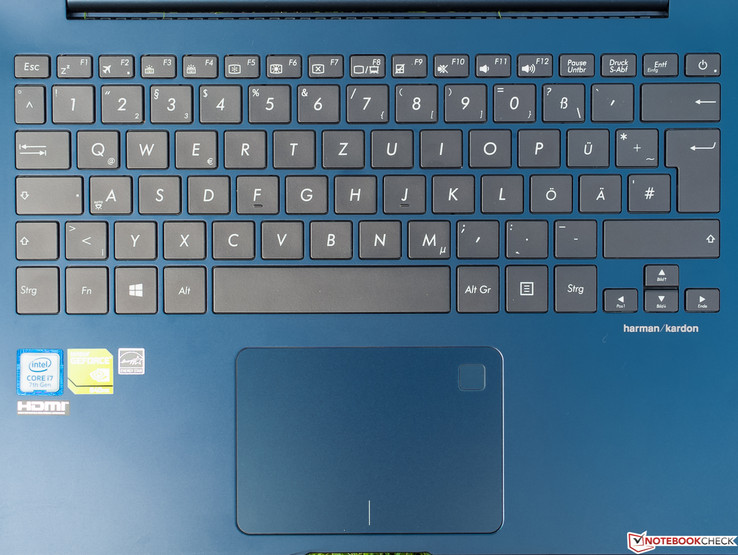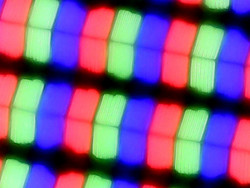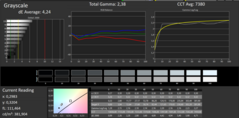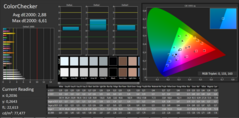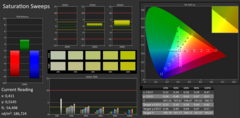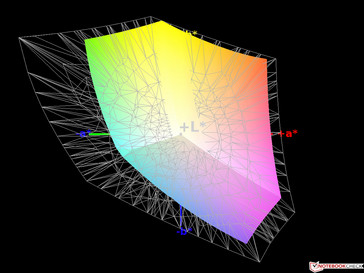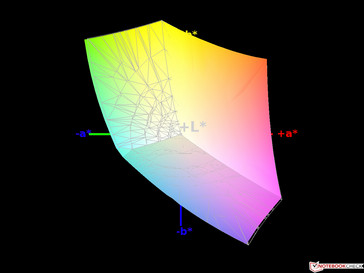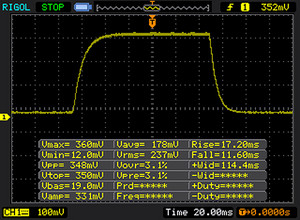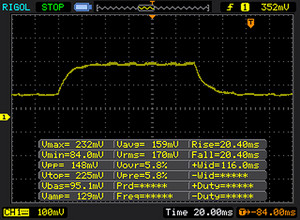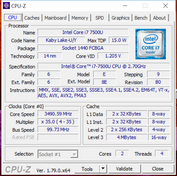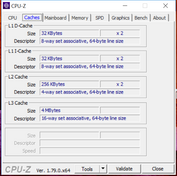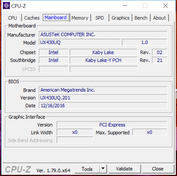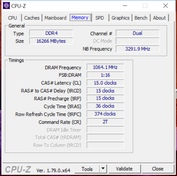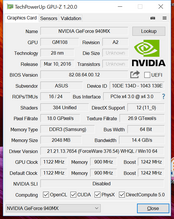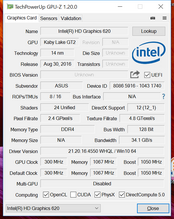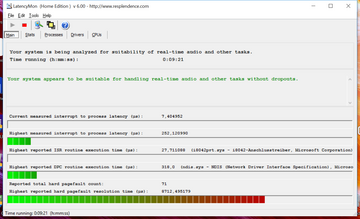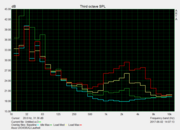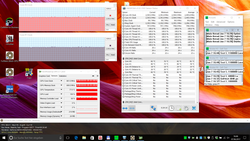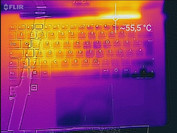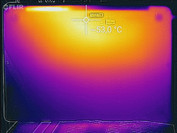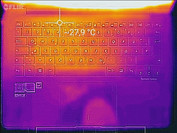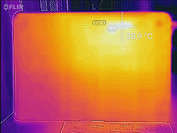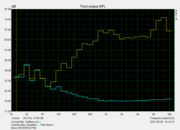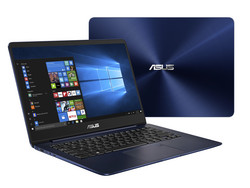Asus Zenbook UX3430UQ (7500U, 940MX, 512 GB) Laptop Review

For the original German review, see here.
One of the Zenbook’s features, that Asus’ marketing department emphasizes most prominently, is its thin display bezels. According to Asus, the display-to-body ratio of 80% means that the Zenbook UX3430UQ is a 14-inch laptop in a 13-inch case. Two models are available, the GV012T (our review unit) and the slightly cheaper GV010T. The only difference is the latter’s smaller SSD (256 GB instead of 512 GB).
The hardware configuration matches the device’s rather high price (around $1,600 in Europe, currently no price available for the US yet): a ULV-class Core i7 microprocessor with 16 GB of RAM, and a dedicated Nvidia GeForce 940MX (lower mid-range) turn the Zenbook from an office-tasks-only into a multimedia notebook equipped with a matte FHD IPS panel running Windows 10 Home. Its orientation towards portability and business usability are highlighted by the included security features.
Since the overall amount of 13- or 14-inch multimedia notebooks is pretty limited, we found it surprisingly hard to find worthy competitors for the Zenbook UX3430UQ. For the sake of this review, we will be comparing the UX3430UQ to the Zenbook UX3410UQ-GV077T, the compact 13-inch multimedia notebook Lenovo IdeaPad 710S Plus, and the much larger Dell XPS 15 2017 9560. The latter was taken into consideration solely to have some quad-core and GTX 1050 scores and values to compare the Zenbook to.
Case
As is the case with most Zenbooks, the base seems to be made of metal and the entire notebook – except for its very thin bezels – is held in what Asus refers to as midnight-blue. Both the matte base and the glossy display lid turned out to be highly effective fingerprint magnets. The only visual highlights are the silver Asus logo on the lid surrounded by concentric grooves and the rounded corners.
The UX3430UQ offers the high case quality we came to expect from Zenbooks. All parts match perfectly and there are no gaps or crevices. The base does not flex or twist unless torsional forces are enormous, and even then it only does so minimally and does not creak at all. The display lid is not as warp-resistant as the base, but it is highly pressure-resistant. It cannot be opened one-handed, and teetering is limited to a minimum. All things considered, the solid and very rigid case matches the device’s high price and left a pretty good overall impression.
We cannot confirm the marketing department’s claim that the UX3430UQ is a 14-inch laptop in a 13-inch case, because the actual 13-inch IdeaPad 710S Plus was both thinner and had a smaller footprint. The UX3430UQ was similarly sized to the other Zenbook, but it was slightly thinner. Overall, we would agree that it is a pretty petite 14-inch notebook.
Connectivity
Connectivity is not particularly outstanding, and the Zenbook lacks both Thunderbolt 3 and a dedicated DisplayPort. What it does have to offer are 1x USB 2.0 (Type-A), 1x USB 3.0 (Type-A), and 1x USB 3.1 Gen. 1 (Type-C). The latter also carries a DisplayPort signal and can be used for external displays. An adapter to HDMI for use with the microHDMI port is also included. All ports are distributed more or less evenly along both sides and are placed towards the rear of the device. The USB 2.0 port on the right side is most likely going to be used for an external mouse so adding another USB 3.0 port here would have been rather moot. While the Zenbook lacks a dedicated Ethernet port, Asus does include a USB Type-A to Ethernet (RJ45) adapter in the box.
SD-Card Reader
Based on the SD-card reader’s pretty poor performance when tested with our Toshiba Exceria Pro SDXC 64 GB UHS-II reference card, we suspect that it is only connected via USB 2.0 instead of the much faster 3.0, just like on the other Zenbook. At the Zenbook’s price point, we would have expected more. The Dell’s card reader seems to be connected via PCIe; however, the discrepancy between the sequential read speeds and the real-world JPEG copy test is striking. Here, the XPS performs about as fast as the Lenovo IdeaPad 710S Plus and is therefore only about as fast as any other USB 3.0 card reader.
| SD Card Reader | |
| average JPG Copy Test (av. of 3 runs) | |
| Lenovo IdeaPad 710S Plus-13IKB | |
| Dell XPS 15 2017 9560 (7300HQ, Full-HD) | |
| Asus Zenbook UX3430UQ-GV012T | |
| Asus Zenbook UX3410UQ-GV077T | |
| maximum AS SSD Seq Read Test (1GB) | |
| Dell XPS 15 2017 9560 (7300HQ, Full-HD) | |
| Lenovo IdeaPad 710S Plus-13IKB | |
| Asus Zenbook UX3430UQ-GV012T | |
| Asus Zenbook UX3410UQ-GV077T | |
Communication
For wireless connectivity, Asus has chosen Intel’s dual-band MIMO 2x2 Wireless-AC 8260 card that offers a maximum transfer speed of 867 Mbps. It supports all common wireless standards as well as the less frequently used 5 GHz band, and even Bluetooth 4.2, although that might require a driver update.
In our benchmarks, the UX3430UQ scored first place in transmitting (666 Mbps) and last place in receiving data (503 Mbps). Oddly enough, the other Zenbook in our test group performed exactly the other way around: last place in transmitting and second place in receiving data.
Security
In addition to the included TPM 2.0 module, Asus has also embedded a fingerprint-reader into the upper-right corner of the touchpad. For reasons unknown to us, the engineers have decided to omit a Kensington lock.
Accessories
The enclosed adapters are a rare find these days, and Asus includes a microHDMI to HDMI and USB Type-A to Ethernet adapter. Also enclosed in the nice blue box are a laptop bag and the charger. Additional accessories specifically designed for this particular Zenbook do not exist.
Maintenance
The device lacks a dedicated maintenance flap, and the battery is not user-replaceable. However, the bottom cover is held in place by nine torx screws and can be easily removed. Since our review model was a shop model, we’ve refrained from taking it apart. This, by the way, might void your warranty.
Warranty
Speaking of which, in European markets Asus sells its Zenbooks with a 24-month limited warranty on the device, and a 12-month limited warranty on the battery. Please see our Guarantees, Return policies and Warranties FAQ for country-specific information.
Input Devices
Keyboard
The desktop-sized chiclet keyboard offers sufficiently large and nicely spaced keys. Key travel is rather shallow, around 1.5 mm, and the actuation point is well defined and easily perceptible. The keystroke differs between large and small keys. The former clatter noticeably and have a very hard keystroke, while the latter are very soft and almost soundless. Accordingly, the keyboard feels mushy and spongy.
Except for a few keys, the labels are easy to read and the keyboard includes a three-stage backlight. The layout is very close to a standard desktop layout; however, the power button is once again located in the upper-right corner, as is quite often the case these days in many a laptop. The keyboard flexes considerably under pressure, and once again we would have expected more of a notebook in this price range.
Touchpad
Asus has opted for a ClickPad without dedicated buttons, and its smooth surface even works very well with moist and slightly wet fingers and is capable of detecting input up to its very edges. The only exception to this is the upper-right corner where the fingerprint reader is located. Fast movements worked very well, and we found no issues in regard to precision, reactivity, or drag & drop via tap.
The two integrated buttons are shallow but very firm and accompanied by a very nice acoustic feedback. The so-called Asus Precision Touchpad is capable of detecting up to four fingers, requires a separate driver, and it even supports handwriting recognition via a dedicated application called “Asus TouchPad Handwriting”.
Display
The only available display for the UX3230UQ is the 14-inch 1920x1080 (FHD) matte IPS panel with a pixel density of 157 ppi. While sufficient from a normal viewing distance, minor aliasing can be detected when getting up close to the display. Panel sharpness was top-notch.
Except for the Lenovo IdeaPad 710S, all contestants including our review unit offered excellent display brightness (366 nits in this case). Average brightness distribution was decent (88%), and only the XPS 15 was better than our review unit. We found no evidence of screen-bleeding or clouding, and a black image seemed very consistent and homogenous.
| |||||||||||||||||||||||||
Brightness Distribution: 88 %
Center on Battery: 377 cd/m²
Contrast: 1038:1 (Black: 0.34 cd/m²)
ΔE Color 2.88 | 0.5-29.43 Ø5
ΔE Greyscale 4.24 | 0.57-98 Ø5.3
99% sRGB (Argyll 1.6.3 3D)
64% AdobeRGB 1998 (Argyll 1.6.3 3D)
69.3% AdobeRGB 1998 (Argyll 2.2.0 3D)
98.7% sRGB (Argyll 2.2.0 3D)
67.1% Display P3 (Argyll 2.2.0 3D)
Gamma: 2.38
| Asus Zenbook UX3430UQ-GV012T Chi Mei CMN14D2 / N140HCE-EN1, , 1920x1080, 14.00 | Lenovo IdeaPad 710S Plus-13IKB LG Philips LP133WF4-SPB1 (LGD04EF), , 1920x1080, 13.30 | Asus Zenbook UX3410UQ-GV077T Chi Mei N140HCE-EN1, , 1920x1080, 14.00 | Dell XPS 15 2017 9560 (7300HQ, Full-HD) Sharp SHP1453 LQ156M1, , 1920x1080, 15.60 | |
|---|---|---|---|---|
| Display | -11% | 0% | 2% | |
| Display P3 Coverage | 67.1 | 65.3 -3% | 67.2 0% | 68.9 3% |
| sRGB Coverage | 98.7 | 82.9 -16% | 99.2 1% | 98.9 0% |
| AdobeRGB 1998 Coverage | 69.3 | 60.6 -13% | 69.3 0% | 70.9 2% |
| Response Times | -9% | -7% | -61% | |
| Response Time Grey 50% / Grey 80% * | 40 ? | 45 ? -13% | 44 ? -10% | 54 ? -35% |
| Response Time Black / White * | 28 ? | 29 ? -4% | 29 ? -4% | 52.4 ? -87% |
| PWM Frequency | 60 ? | |||
| Screen | -12% | 2% | -11% | |
| Brightness middle | 353 | 343 -3% | 381 8% | 400 13% |
| Brightness | 366 | 306 -16% | 368 1% | 392 7% |
| Brightness Distribution | 88 | 81 -8% | 84 -5% | 89 1% |
| Black Level * | 0.34 | 0.3 12% | 0.3 12% | 0.26 24% |
| Contrast | 1038 | 1143 10% | 1270 22% | 1538 48% |
| Colorchecker dE 2000 * | 2.88 | 4.73 -64% | 2.84 1% | 4.9 -70% |
| Colorchecker dE 2000 max. * | 6.61 | 9.05 -37% | 6.5 2% | 11 -66% |
| Greyscale dE 2000 * | 4.24 | 3.29 22% | 4.02 5% | 7.2 -70% |
| Gamma | 2.38 92% | 2.36 93% | 2.42 91% | 2.11 104% |
| CCT | 7380 88% | 6437 101% | 7430 87% | 6911 94% |
| Color Space (Percent of AdobeRGB 1998) | 64 | 54 -16% | 56 -12% | 64.2 0% |
| Color Space (Percent of sRGB) | 99 | 83 -16% | 86 -13% | 98.9 0% |
| Total Average (Program / Settings) | -11% /
-11% | -2% /
1% | -23% /
-15% |
* ... smaller is better
Since the contrast ratio is the ratio between brightness and black level, our review unit scored a very respectable 1,038:1. However, given that all notebooks in our test group featured a black level of 0.3 nits or less this meant last place for the UX3430UQ. The other displays were either slightly brighter or had a slightly lower black level. Subjectively, a completely black screen was very black indeed but failed to get as black as the bezels. That would have required an AMOLED display.
Color accuracy out of the box was decent, and DeltaE deviations of 2.88 (colors) and 4.24 (grayscales) were slightly below or fairly close to their ideal values of less than 3. Unsurprisingly, the other Zenbook in our test group achieved the same results: both notebooks are equipped with the exact same panel. sRGB coverage is almost complete; AdobeRGB coverage is 64%. The UX3430UQ is thus not going to stand in the way of non-professional photo-editing aspirations.
How different seemingly identical panels can turn out can be seen in the differences between the two Zenbooks: the 3410UQ has a 22% higher contrast ratio but a considerably worse color coverage.
Outdoor usage even on bright days is no problem at all, thanks to the UX3430UQ’s very bright and matte panel. On an overcast day, we had absolutely no trouble finding the ideal position for optimal readability every time. The right photo was taken with the screen aimed directly at the cloudy sky.
Display Response Times
| ↔ Response Time Black to White | ||
|---|---|---|
| 28 ms ... rise ↗ and fall ↘ combined | ↗ 17 ms rise | |
| ↘ 11 ms fall | ||
| The screen shows relatively slow response rates in our tests and may be too slow for gamers. In comparison, all tested devices range from 0.1 (minimum) to 240 (maximum) ms. » 67 % of all devices are better. This means that the measured response time is worse than the average of all tested devices (21.5 ms). | ||
| ↔ Response Time 50% Grey to 80% Grey | ||
| 40 ms ... rise ↗ and fall ↘ combined | ↗ 20 ms rise | |
| ↘ 20 ms fall | ||
| The screen shows slow response rates in our tests and will be unsatisfactory for gamers. In comparison, all tested devices range from 0.2 (minimum) to 636 (maximum) ms. » 56 % of all devices are better. This means that the measured response time is worse than the average of all tested devices (33.7 ms). | ||
Screen Flickering / PWM (Pulse-Width Modulation)
| Screen flickering / PWM not detected | ||
In comparison: 53 % of all tested devices do not use PWM to dim the display. If PWM was detected, an average of 17900 (minimum: 5 - maximum: 3846000) Hz was measured. | ||
Processor
The CPU, an Intel Core i7-7500U (2x 2.7 – 3.5 GHz, Hyper-Threading, 15 W TDP), is one of the fastest CPUs from Intel’s current Kaby Lake line-up. Thanks to optimized manufacturing processes and a slightly higher clock rate, the i7-7500U is around 15% faster than its direct predecessor, the i7-6500U (2x 2.5 – 3.1 GHz). Considering the circumstances, this is a substantial performance gain. In multi-core load scenarios, the CPU is limited by its TDP. Maximum turbo boost on two cores is up to 3.5 GHz but can’t be upheld for long.
Overall, the CPU performed as expected. The fastest i7-7500U we found in our database was around 9% faster, and the average Cinebench R15 score for this particular CPU was around 3% lower than on the UX3430UQ. In the Cinebench multi-core loop, the CPU reduced its maximum turbo boost during the second iteration already. The CPU was unable to utilize its full turbo potential for prolonged periods of time, but it fared better than the same CPU in the recently reviewed Asus AsusPro B9440UA (Core i7, 16 GB). Thus, the additional benefits when compared to the i5-7200U (2x 2.5 – 3.1 GHz) are quite obvious. The results are identical on battery.
System Performance
Running PCMark 8 to determine system performance, the Zenbook UX3430UQ-GV012T (dual-core, 940MX) and the XPS 15 2017 9560 (quad-core, GTX 1050) were fairly close to each other. We blame the XPS 15’s slow storage. The IdeaPad 710S was unable to keep up due to the fact that its CPU only performed as fast as the much slower i5-7200U.
Subjectively, system performance was snappy and decent thanks to the system’s SSD. Boot times and application launch times were short, and extensive multitasking was no problem thanks to the notebook’s 16 GB of RAM.
| PCMark 8 | |
| Home Score Accelerated v2 | |
| Asus Zenbook UX3410UQ-GV077T | |
| Asus Zenbook UX3430UQ-GV012T | |
| Dell XPS 15 2017 9560 (7300HQ, Full-HD) | |
| Lenovo IdeaPad 710S Plus-13IKB | |
| Work Score Accelerated v2 | |
| Dell XPS 15 2017 9560 (7300HQ, Full-HD) | |
| Asus Zenbook UX3430UQ-GV012T | |
| Lenovo IdeaPad 710S Plus-13IKB | |
| PCMark 8 Home Score Accelerated v2 | 3913 points | |
| PCMark 8 Work Score Accelerated v2 | 4812 points | |
Help | ||
Storage Devices
Asus opted for a moderately fast SATA III SSD that barely reached the interface’s limit of 500 MB/s in sequential reading and writing. The much more important 4K read performance was decent, and at 30 MB/s the SSD performed as expected of a modern SSD.
The Zenbook UX3410UQ’s 256 GB SSD performed significantly worse, and the combination of SSD cache and regular HDD the Dell XPS 15 is equipped with did not stand a chance against any SSD-equipped notebook. The Lenovo IdeaPad’s NVMe SSD was a very good example of what modern PCIe SSDs are capable of these days. Real-world experience did not reflect this massive difference between the NVMe and the SATA III SSD, though.
| Asus Zenbook UX3430UQ-GV012T SanDisk SD8SN8U512G1002 | Lenovo IdeaPad 710S Plus-13IKB Samsung PM961 NVMe MZVLW512HMJP | Asus Zenbook UX3410UQ-GV077T SanDisk SD8SNAT256G1002 | Dell XPS 15 2017 9560 (7300HQ, Full-HD) WDC WD10SPCX-75KHST0 + SanDisk Z400s M.2 2242 32 GB Cache | |
|---|---|---|---|---|
| CrystalDiskMark 3.0 | 143% | -14% | -82% | |
| Read Seq | 500 | 1577 215% | 497 -1% | 123 -75% |
| Write Seq | 457.4 | 1472 222% | 323.7 -29% | 74.2 -84% |
| Read 512 | 345.6 | 1165 237% | 289 -16% | 101.7 -71% |
| Write 512 | 415 | 1244 200% | 288 -31% | 42.51 -90% |
| Read 4k | 28.34 | 54.8 93% | 22.78 -20% | 10.84 -62% |
| Write 4k | 56.8 | 121.5 114% | 79.5 40% | 1.021 -98% |
| Read 4k QD32 | 311.3 | 407.5 31% | 147 -53% | 69.8 -78% |
| Write 4k QD32 | 251.1 | 321.4 28% | 257.2 2% | 1.057 -100% |
GPU Performance
Back when it was first released in early 2016, Nvidia's GeForce 940MX (384 shaders, 64-bit bus) was a somewhat decent low to mid-range GPU. However, since the release of Pascal, mid-range has been redefined and nowadays refers to much more powerful GPUs: the GeForce GTX 1050 or GTX 1050 Ti, for example. This raises the question of why Asus decided to opt for the outdated 940MX in the first place.
In the case of the UX3430UQ, the GPU is equipped with 2 GB of DDR3 RAM (the slower of the two options) and is only a mere 30% faster than the integrated Intel HD Graphics 620 GPU. Sure, in some games this can make a huge difference, but of all 940MX laptops ever reviewed by us, the UX3430UQ is in second to last place and the UX3410UQ in last place in 3DMark 11. The difference between our review model and the fastest 940MX in our review database is a whopping 44%! Fire Strike (2013) showed similar results. Running 3DMark 11 on battery yielded the same results.
| 3DMark 11 - 1280x720 Performance GPU | |
| Dell XPS 15 2017 9560 (7300HQ, Full-HD) | |
| Lenovo IdeaPad 710S Plus-13IKB | |
| Asus Zenbook UX3430UQ-GV012T | |
| Asus Zenbook UX3410UQ-GV077T | |
| Asus Zenbook UX3410UA | |
| 3DMark - 1920x1080 Fire Strike Graphics | |
| Dell XPS 15 2017 9560 (7300HQ, Full-HD) | |
| Lenovo IdeaPad 710S Plus-13IKB | |
| Asus Zenbook UX3430UQ-GV012T | |
| Asus Zenbook UX3410UA | |
| 3DMark 11 Performance | 2335 points | |
| 3DMark Cloud Gate Standard Score | 6852 points | |
| 3DMark Fire Strike Score | 1373 points | |
Help | ||
Gaming Performance
In demanding and graphically exquisite games, such as The Witcher 3 or Ghost Recon Wildlands, the 940MX is only fast enough for minimal details at 1024x768 or 1280x720. Medium or even high details are only doable in older and/or less-demanding games. The almost negligible edge the 940MX has over the integrated GPU means that more games are playable at all and some can even be played on medium instead of low settings.
| low | med. | high | ultra | |
| Diablo III (2012) | 70.2 | 66.8 | 41.7 | |
| The Witcher 3 (2015) | 27.8 | 17.3 | ||
| Farming Simulator 17 (2016) | 79.7 | 34.1 | 23.3 |
Emissions
System Noise
The UX3430UQ’s fan always runs, even in passive-cooling Windows energy profile settings. From a distance of around 1 m it is noticeable, but barely so. Short bursts, for example while browsing the web, have no effect on the fan whatsoever. However, streaming a video (e.g. on YouTube) does cause the fan to rev up considerably, and it becomes audible from further away as well.
Running Prime95 and FurMark simultaneously to simulate maximum CPU and GPU stress, the fan speed increases continuously until it reaches its maximum level. Nevertheless, even on maximum speed the fan remained comparatively quiet and undisturbing, and we found no evidence of coil whine or other irregularities. All things considered, the UX3430UQ is a pretty quiet notebook.
Noise Level
| Idle |
| 30.8 / 30.8 / 32.4 dB(A) |
| Load |
| 35.1 / 38.4 dB(A) |
 | ||
30 dB silent 40 dB(A) audible 50 dB(A) loud |
||
min: | ||
Temperature
The bottom heated up considerably during our stress test and reached a maximum of 50 °C. It thus became too hot to be used on the lap. The keyboard and even the palm rests got almost uncomfortably warm while playing demanding games. When idle or under moderate load, the device stayed nice and cool, and surface temperatures were only up to 4 °C above ambient temperature.
The CPU clock speed dropped to between 2.4 and 2.6 GHz when running Prime95 and FurMark simultaneously. Given its base clock speed of 2.7 GHz we must thus deduce that the CPU does throttle somewhat under heavy load. CPU temperature never exceeded 82 °C, though. The GPU throttled even worse, and after a few minutes of extreme load clock speeds dropped from the 940MX’s initial 900 MHz to between 405 and 800 MHz, alternating quickly back and forth. With GPU-Z, we were able to determine the cause for this behavior: apparently, the GPU’s thermal limit is set to 77 °C. In all fairness we must add that real-world gaming load fluctuates more and thus varies greatly from the synthetic maximum GPU load caused by FurMark. Thus, GPU-throttling while running games should not be as problematic as it was during our stress test.
(±) The maximum temperature on the upper side is 44 °C / 111 F, compared to the average of 35.9 °C / 97 F, ranging from 21.4 to 59 °C for the class Subnotebook.
(-) The bottom heats up to a maximum of 50.2 °C / 122 F, compared to the average of 39.4 °C / 103 F
(+) In idle usage, the average temperature for the upper side is 25.5 °C / 78 F, compared to the device average of 30.7 °C / 87 F.
(+) The palmrests and touchpad are reaching skin temperature as a maximum (33.4 °C / 92.1 F) and are therefore not hot.
(-) The average temperature of the palmrest area of similar devices was 28.3 °C / 82.9 F (-5.1 °C / -9.2 F).
Speakers
The two downward-facing speakers at the bottom are decently loud, and they are suitable for medium-sized rooms. Unfortunately, mids and highs are too pronounced and compressed. When playing pop music at higher volumes, the highs are somewhat obtrusive despite the lack of distortions.
The overall dynamic range surprised us, and while bass is missing entirely it is somewhat replicated in the high-frequency range. Some songs even have a hint of auditory spaciousness to them. Voices became more natural at less than maximum volume.
Asus Zenbook UX3430UQ-GV012T audio analysis
(±) | speaker loudness is average but good (75 dB)
Bass 100 - 315 Hz
(-) | nearly no bass - on average 18.9% lower than median
(±) | linearity of bass is average (12.2% delta to prev. frequency)
Mids 400 - 2000 Hz
(+) | balanced mids - only 3.4% away from median
(+) | mids are linear (6.9% delta to prev. frequency)
Highs 2 - 16 kHz
(+) | balanced highs - only 2.7% away from median
(+) | highs are linear (5% delta to prev. frequency)
Overall 100 - 16.000 Hz
(±) | linearity of overall sound is average (20.4% difference to median)
Compared to same class
» 60% of all tested devices in this class were better, 8% similar, 31% worse
» The best had a delta of 5%, average was 19%, worst was 53%
Compared to all devices tested
» 48% of all tested devices were better, 8% similar, 44% worse
» The best had a delta of 4%, average was 25%, worst was 134%
Lenovo IdeaPad 710S Plus-13IKB audio analysis
(±) | speaker loudness is average but good (73 dB)
Bass 100 - 315 Hz
(-) | nearly no bass - on average 21.4% lower than median
(±) | linearity of bass is average (12.2% delta to prev. frequency)
Mids 400 - 2000 Hz
(±) | higher mids - on average 6.7% higher than median
(±) | linearity of mids is average (10.6% delta to prev. frequency)
Highs 2 - 16 kHz
(+) | balanced highs - only 2.2% away from median
(+) | highs are linear (6.9% delta to prev. frequency)
Overall 100 - 16.000 Hz
(±) | linearity of overall sound is average (24.4% difference to median)
Compared to same class
» 79% of all tested devices in this class were better, 5% similar, 16% worse
» The best had a delta of 5%, average was 19%, worst was 53%
Compared to all devices tested
» 70% of all tested devices were better, 6% similar, 24% worse
» The best had a delta of 4%, average was 25%, worst was 134%
Asus Zenbook UX3410UQ-GV077T audio analysis
(±) | speaker loudness is average but good (73 dB)
Bass 100 - 315 Hz
(±) | reduced bass - on average 12% lower than median
(+) | bass is linear (4.5% delta to prev. frequency)
Mids 400 - 2000 Hz
(±) | higher mids - on average 6.5% higher than median
(+) | mids are linear (6.7% delta to prev. frequency)
Highs 2 - 16 kHz
(+) | balanced highs - only 3.9% away from median
(+) | highs are linear (4.8% delta to prev. frequency)
Overall 100 - 16.000 Hz
(±) | linearity of overall sound is average (17% difference to median)
Compared to same class
» 38% of all tested devices in this class were better, 8% similar, 54% worse
» The best had a delta of 5%, average was 19%, worst was 53%
Compared to all devices tested
» 25% of all tested devices were better, 7% similar, 67% worse
» The best had a delta of 4%, average was 25%, worst was 134%
Dell XPS 15 2017 9560 (7300HQ, Full-HD) audio analysis
(+) | speakers can play relatively loud (87 dB)
Bass 100 - 315 Hz
(-) | nearly no bass - on average 15.8% lower than median
(±) | linearity of bass is average (13.9% delta to prev. frequency)
Mids 400 - 2000 Hz
(+) | balanced mids - only 4.3% away from median
(±) | linearity of mids is average (7.1% delta to prev. frequency)
Highs 2 - 16 kHz
(+) | balanced highs - only 3.1% away from median
(±) | linearity of highs is average (7.9% delta to prev. frequency)
Overall 100 - 16.000 Hz
(+) | overall sound is linear (13.5% difference to median)
Compared to same class
» 21% of all tested devices in this class were better, 5% similar, 74% worse
» The best had a delta of 5%, average was 18%, worst was 45%
Compared to all devices tested
» 11% of all tested devices were better, 3% similar, 85% worse
» The best had a delta of 4%, average was 25%, worst was 134%
Frequency diagram (checkboxes selectable/deselectable!)
Energy Management
Power Consumption
Bigger display, quad-core CPU, hard drive, and a GeForce GTX 1050: it was no surprise to us that the Dell XPS 15 2017 required the most power in all load scenarios except when idle. The latter has our review unit shine with the lowest power consumption among its rivals, and under load power consumption of both Zenbooks and the IdeaPad was fairly similar. Considering the maximum of 46 W, the enclosed 65 W charger is amply dimensioned.
| Off / Standby | |
| Idle | |
| Load |
|
| Asus Zenbook UX3430UQ-GV012T i7-7500U, GeForce 940MX, SanDisk SD8SN8U512G1002, IPS, 1920x1080, 14.00 | Lenovo IdeaPad 710S Plus-13IKB i7-7500U, GeForce 940MX, Samsung PM961 NVMe MZVLW512HMJP, IPS, 1920x1080, 13.30 | Asus Zenbook UX3410UQ-GV077T i7-7500U, GeForce 940MX, SanDisk SD8SNAT256G1002, IPS, 1920x1080, 14.00 | Dell XPS 15 2017 9560 (7300HQ, Full-HD) i5-7300HQ, GeForce GTX 1050 Mobile, WDC WD10SPCX-75KHST0 + SanDisk Z400s M.2 2242 32 GB Cache, LED IGZO IPS InfinityEdge, 1920x1080, 15.60 | |
|---|---|---|---|---|
| Power Consumption | -19% | -15% | -109% | |
| Idle Minimum * | 2.6 | 3.6 -38% | 3.5 -35% | 6.6 -154% |
| Idle Average * | 5.9 | 7.4 -25% | 6.6 -12% | 9 -53% |
| Idle Maximum * | 6.25 | 8.7 -39% | 7.1 -14% | 10.7 -71% |
| Load Average * | 42 | 43 -2% | 30 29% | 77.5 -85% |
| Load Maximum * | 46 | 42 9% | 65 -41% | 130 -183% |
* ... smaller is better
Battery Life
All four devices in our test group had similarly sized batteries and performed quite similarly overall as well, except of course for the XPS 15 once again. When idle, our review unit lasted an impressive 21.5 hours, and it outperformed the Lenovo IdeaPad by 36% in the real-world Wi-Fi test and beat the other Zenbook by a few minutes as well. Thus, the Zenbooks seem to offer decent and long battery life.
| Asus Zenbook UX3430UQ-GV012T i7-7500U, GeForce 940MX, 50 Wh | Lenovo IdeaPad 710S Plus-13IKB i7-7500U, GeForce 940MX, 46 Wh | Asus Zenbook UX3410UQ-GV077T i7-7500U, GeForce 940MX, 48 Wh | Dell XPS 15 2017 9560 (7300HQ, Full-HD) i5-7300HQ, GeForce GTX 1050 Mobile, 56 Wh | |
|---|---|---|---|---|
| Battery Runtime | -36% | -3% | -35% | |
| Reader / Idle | 1292 | 468 -64% | 565 -56% | |
| WiFi v1.3 | 527 | 338 -36% | 511 -3% | 334 -37% |
| Load | 97 | 89 -8% | 84 -13% |
Verdict
Pros
Cons
Why oh why did Asus opt for the almost ancient and most certainly outdated GeForce 940MX? And why did they not manage a decent implementation of this well-known chip to boot? Remember, the Zenbook’s 940MX is only around 30 % faster than the integrated Intel HD Graphics 620. The only remaining pretense of “multimedia” can be found in the notebook’s excellent screen. Multimedia? Certainly not.
Business? Certainly so. The Asus Zenbook UX3430UQ is much more of a business and office companion, and it won’t stand in the way of non-professional photo-editing aspirations. Thanks to its thin bezels, the well-made 14-inch case is fairly compact. Very long battery life and the security features included in the notebook make it very portable. If not for the rather loud large keys on the keyboard, the device would have been very silent overall. All things considered, the input devices should please most prolific writers.
Office and business users looking for a presentable high-quality portable notebook are the device’s primary target audience. Gamers, on the other hand, should steer clear.
At their current price levels of $1,500 (GV010T) and $1,600 (GV012T), both UX3430UQ models are too expensive. Waiting for a while could end up rewarding potential buyers with a more adequate price-performance ratio.
Asus Zenbook UX3430UQ-GV012T
-
07/05/2017 v6(old)
Sven Kloevekorn


 Deutsch
Deutsch English
English Español
Español Français
Français Italiano
Italiano Nederlands
Nederlands Polski
Polski Português
Português Русский
Русский Türkçe
Türkçe Svenska
Svenska Chinese
Chinese Magyar
Magyar